The Estate Map
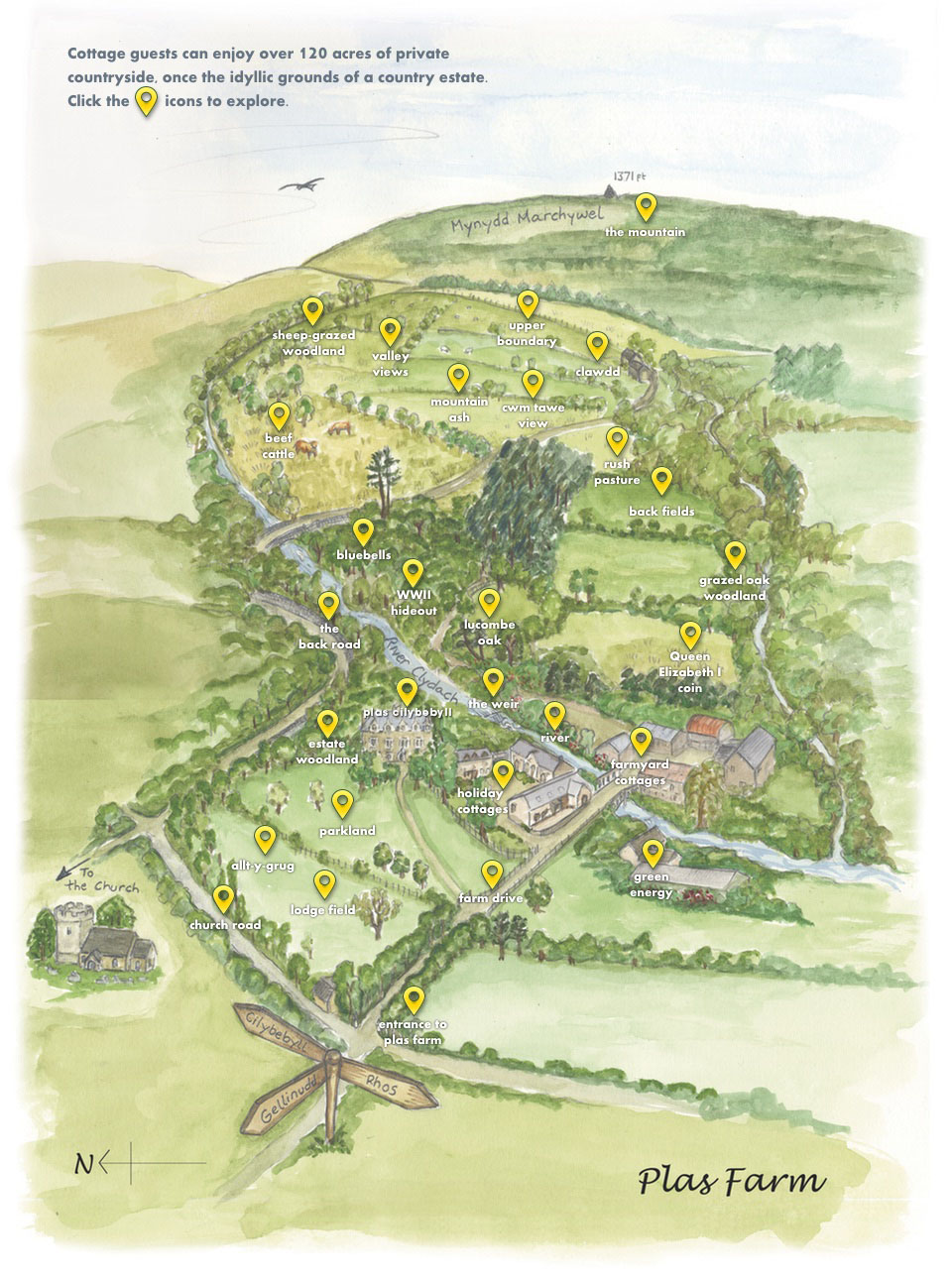

Mynydd Marchywel (1,371 feet)
The mountain upon which the farm cottages sit, Mynydd Marchywel (Hywel's Stallion), is one of a series of stepped escarpments that rise to heights of over a 1,000 feet across the region, giving the South Wales landscape its areas of wild, barren moorland. The summit of the mountain is marked by three prehistoric funerary and ritual stone circles.

The Upper Boundary
The upper boundary of the farm is a great spot to see birds, where the farmland meets the barren mountainous moorland. Look out for charms of goldfinches flittering amongst the thistle heads, buzzards soaring over the mountain on thermals, stonechats sitting on the fence ‘tchacking’ away, skylarks singing their chirruping song, linnets, wheatears and lots of meadow pipits.

Sheep Grazed Woodland
This picture was taken on The Plas Farm Trail. You can spot the way-marker on the fence post and a stile between the trees in the distance. It is a magical part of the trail and a lovely place to stop for a picnic. The trees are mainly silver birch and willow. Carpets of unusual mosses join the trees and small native bluebells sprout through the green grazed grass.

Valley Views
This September landscape was taken from the sheltered slopes behind the holiday cottages. The foreground is dominated by striking mountain ash trees, laden with red berries. In the middle distance, Welsh mountain sheep graze on grassy slopes and in the far distance, the dramatic ice-carved western side of the Swansea Valley is coloured shades of yellow by the autumn sun. This barren rocky mountain is Allt-y-grug, which translates as The Hillside of Heather.
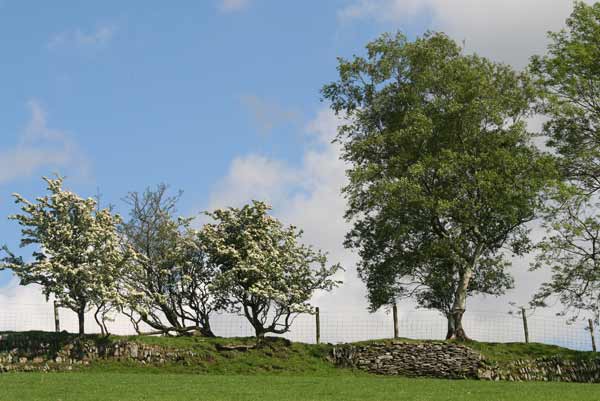
Historic Field Boundary
A characteristic feature of the Welsh landscape - an earth bank faced with vertical stones, or clawdd, upon which sits a modern stock proof barbed wire fence. In Wales, most field boundaries are less than 200 years old, making them a relatively new addition to the landscape. Very often a clawdd will have (or will have had) a hedge on top of it. It is likely that the three hawthorns and silver birch in the picture are the remains of an old hedge. The earth core can be a haven for small mammals – more so than a dry stone wall. Something in excess of 80% of all the recorded flowering plant species in Wales have been found on cloddiau (plural of clawdd).
The clawdd is most common in cattle areas where there is less need for height in terms of stock proofing. If additional stock proofing was required dead wood or gorse would have been piled on top of the structure. Luckily for our generation, in 1867, Lucien B. Smith of Kent, Ohio developed the first wire technology capable of restraining cattle. He had invented barbed wire. In 1874, a Wild West farmer called Joseph Glidden improved his design and started to produce barbed wire in the form we recognize today. Over a century later and we still haven’t bettered his idea.
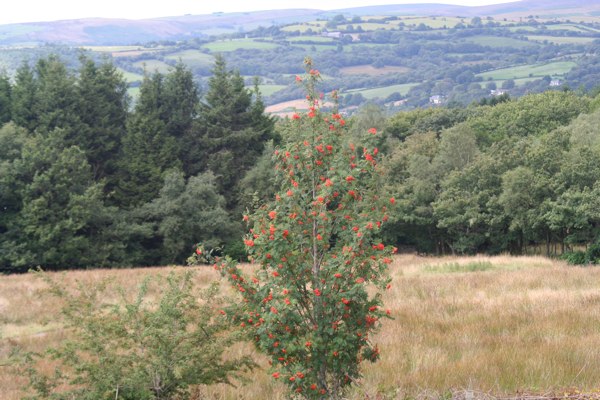
Mountain Ash
The upper fields of Plas Farm are have wonderful views of the surrounding countryside. You will start to notice mountain trees amongst the oaks that border the fields. Look out for the beautiful red berried rowan (or mountain ash), crab apples and you will even pass a wild damson tree.
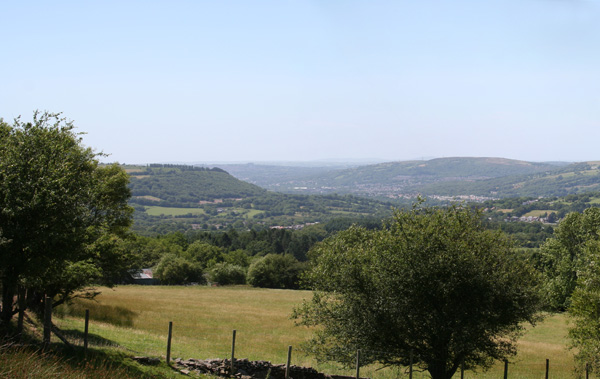
Cwm Tawe View
Plas Farm enjoys superb views of the world famous Swansea Valley - in Welsh, Cwm Tawe - which stretches from the Brecon Beacons in the north to the seaside city of Swansea in the South. It was shaped by glacial action millenia ago and has seen great changes through the rise and fall of the iron and coal industries over the past 200 years, as one of the main cradles of the industrial revolution. The Swansea Valley was to industry what the Silicon Valley is to IT today. From this point you will be able to pick out landmarks such as the largest building on the horizon - the UK's Driving and Vehicle Licensing Agency. You will also enjoy views of Pontardawe - the spire of St Peter's and the Golf Club high on the hill that overlooks the town.
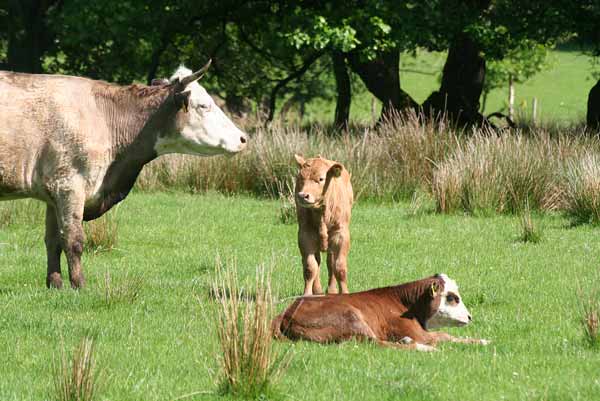
Beef Cattle Grazing in Early Summer
Beef cattle of varying breeds may be seen grazing Plas Farm including Welsh Black, Hereford, Charolais and Limousin. May is a good month to spot some cute calves. A beef cow is dry all winter, calves in the spring and rears its offspring over the summer months.

Rush Pasture
This sheltered rush pasture is a splendid place to spot wildlife. Listen for delights such as the grasshopper warbler and the reed bunting who like to nest here. Wild flowers like tormentil and devil's bit scabious grow here with the odd solitary foxglove towering above the rushes. This is also a great place to spot butterflies - look for orange tips on the milk flowers as well as ringlets and small skippers near the margins where tadpoles can be seen every spring.
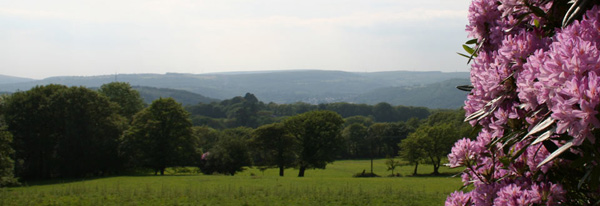
Back Fields
The "back fields" at Plas Farm are a series of three sheltered grassy fields that run uphill from the farmyard, linking the flat parkland areas in front of the cottages to the rush pasture and open hillside areas behind the cottages where one can enjoy panoramic views of the Swansea Valley, Swansea Bay, the Bristol Channel and England beyond, Brecon Beacons National Park and on a clear day, Narnia..
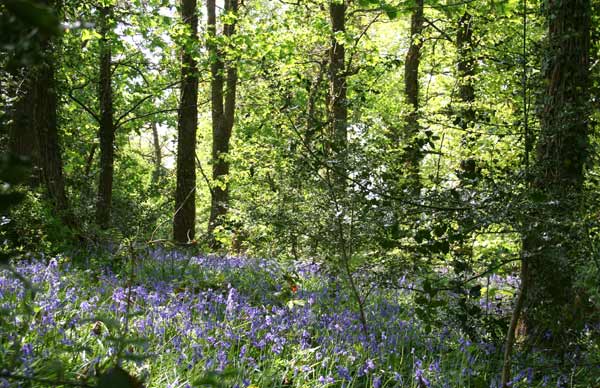
Bluebell Woodland
The UK is home to half of the world's population of bluebells and you'll be pleased to know we have lots of them at Plas Farm. The Welsh name Clychau's Gog translates as Cuckoo Bells since they flower around the same time the cuckoo is first heard in springtime. Our cottages come with their own private bluebell woodland and in case you were wondering, cuckoos have holidayed with us for as long as anyone can remember. They're very naughty and sometimes push residents out of their beds.
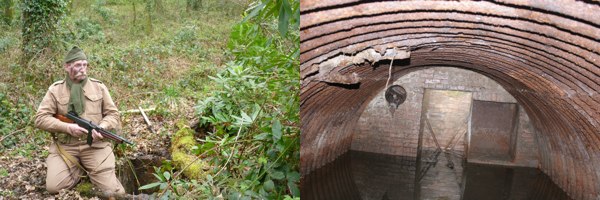
World War Two British Resistance Hideout
Will you be able to find our secret underground hide-out? Located near a path that runs through our bluebell woodland, it was built by the British Resistance Movement during World War II, the world’s first resistance organization ever to be established in advance of an invasion, and widely regarded as the forerunners of today’s SAS.
At this time, an invasion of Britain was considered imminent so Churchill ordered that small teams of local men who know their countryside intimately were recruited secretly from the Home Guard and given specialist training in sabotage and guerrilla warfare. The Units were organised in patrols of between four and eight men, with each patrol having a specially constructed Operational Base (also called a hide or hide-out), usually hidden in woodland. The hideout at Plas Farm is one of very few to have survived in Britain and is listed by the government as a Scheduled Ancient Monument in recognition of its national importance as a significant relic from the Second World War.

Lucombe Oak
Keeping watch over farmyard activities, this large uncommon tree, a hybrid of Turkey Oak and Cork Oak, was first noted by William Lucombe, an Exeter nurseryman, in the 1760s. It has mossy acorn cups and pointy lobes on its leaves like the Turkey Oak and keeps its leaves throughout the winter until just before new growth appears, like its other parent, the Cork Oak. Legend has it that Lucombe was so impressed with the timber that he that he felled his original tree in 1785 and kept planks of it under his bed to make a coffin. By the time he died at the age of 102, his timber had rotted beyond use so another tree was felled and used instead.
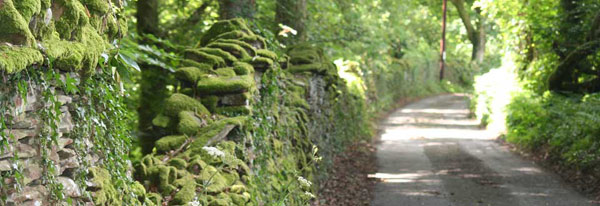
Back Road
The back road is a long winding country lane that helps to complete a circular walk from the holiday cottage doorstep, up the hill to the top of Plas Farm and back down to the cottages via the crossroads in the hamlet of Cilybebyll. Enjoy wonderful views of the river valley over the mossy stone wall. In late Spring you'll see spectacular varieties of rhododendron, imported exotics planted by the Victorian gentry as an expression of wealth, social prominence and extravagant lifestyle. The deep shades of red, varying hues of mauve, pink and white are a sight to behold.

Grazed Oak Woodland
A beautiful place for a summer picnic. Sit among the majestic oak trees and watch the wildlife. Enjoy the birdsong and the tinkling of a small mountain stream runs as it runs down the hillside to join the River Clydach near the holiday cottages.

1578 Queen Elizabeth I Sixpence
The coin found here was minted when Shakespeare was a teenager, Sir Francis Drake was circumnavigating the globe and Plas Farm had yet to see a potato. The population of Britain was just over 4 million (compared to over 64 million today) and the flush toilet had not yet been invented.
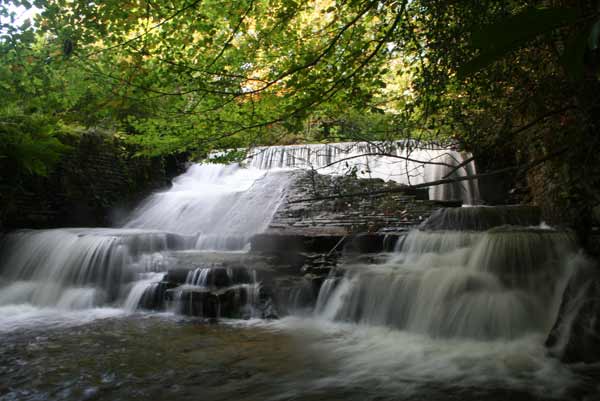
The Weir
Plas Farm's spectacular weir was used to raise the level of the River Clydach such that water could be run in a wooden tar-lined trough along the back of what is now Y Stabl and Ty Cerbyd holiday cottages (you can still see some of the tar on the walls) and onto an overshot waterwheel that was part of Bwthyn Y Saer holiday cottage. It was used to power machines including a turnip pulper that was located in what is now the master bedroom in Bwthyn Y Saer.

The River Clydach
The holiday cottages sit on the bank of the picturesque River Clydach where wildlife flourishes. See wild trout leaping from the crystal clear waters, the disappearing act of a dipper, or a grey wagtail hopping from stone to stone. There are also visits from the heron and if you're very lucky you may even see an otter passing through.
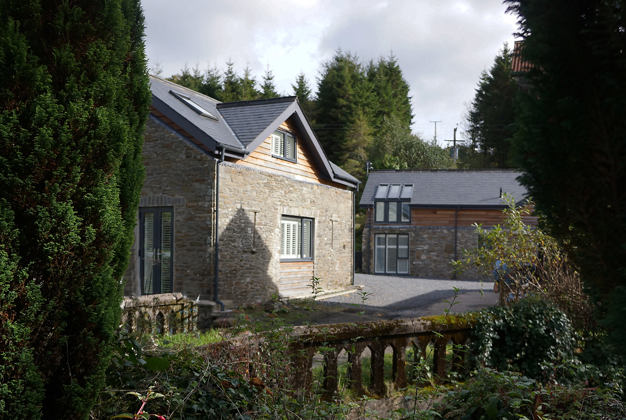
Holiday Cottages
Lloc Llo and Ty Gambo are situated opposite each other in the old farmyard. Both cottages are modern and minimalist in design.
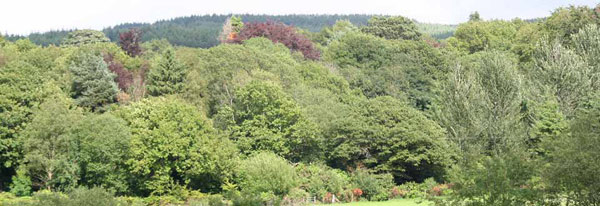
Estate Woodland
Many wonderful varieties of tree have been planted at Plas Farm over the centuries, making it a wonderful place to enjoy autumn colours. There are a mixture of exotics and native trees. The British Isles has 34 native tree species, 27 of which have been spotted growing at Plas Farm. Over 60 bird species have been noted and 20 types of butterfly!

Plas Cilybebyll
French chateau-style Welsh manor with a history spanning centuries. Exceptionally photogenic and a wonderful location for family get togethers and events

Holiday Cottages
The holiday cottages at Plas Farm are set around a courtyard on the bank of the River Clydach. They were originally outbuildings of the Plas Cilybebyll Estate and include a magnificent Georgian Coachhouse.
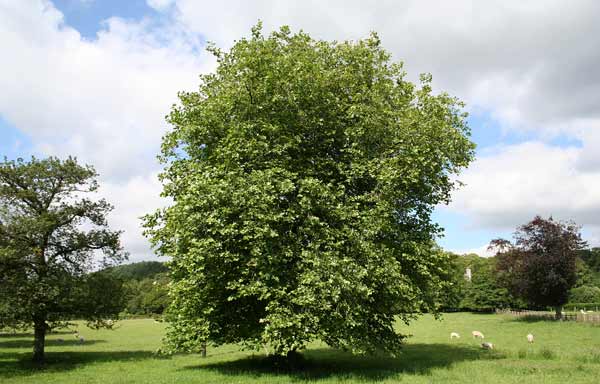
Parkland
Plas Farm is also home to a wide variety of beautiful trees. Many were planted many years ago to beautify the grounds of the Plas Cilybebyll estate. You may find some of them in the parkland that surrounds the holiday cottages.
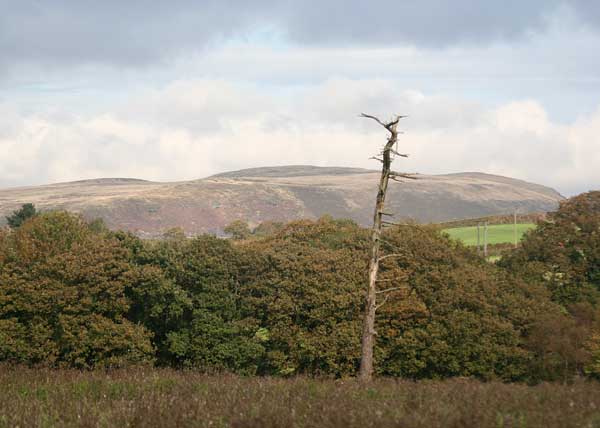
Mynydd Allt-y-grug from the Lodge Field
This October landscape was taken from the 'lodge field' in front of the holiday cottages. The foreground is dominated by a patch of withering thistles. In the middle distance, the Welsh Oaks are starting to take on their autumn colours. In the distance, the dramatic ice-carved western side of the Swansea Valley enjoys the autumn sun. This barren rocky mountain is Allt-y-grug, which translates as The Hillside of Heather.
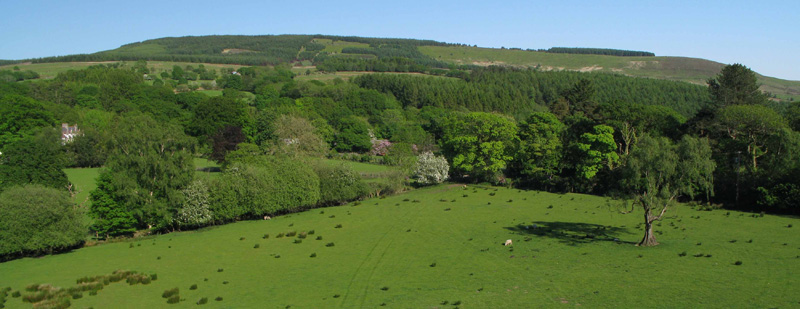
Mynydd Marchywel from The Lodge Field
The summertime at Plas Farm. Sheep graze in the lodge field, colourful rhododendrons flower in the hedgerows and Mynydd Marchywel, at over a thousand feet, provides a dramatic backdrop. The lonely tree in the middle of the field is a gnarled old silver birch whose only friend is a wise old tawny owl.
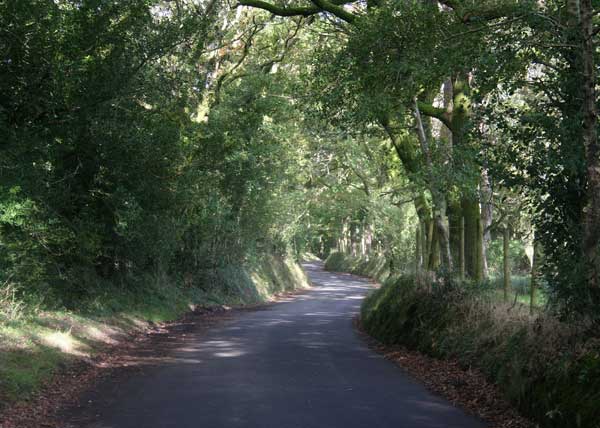
Winding Country Lane
Church Road links the gateway to Plas Farm with the crossroads in Cilybebyll. There are some great places to lean on a gate, chew on a piece of straw, and enjoy views across Plas Farm's historic parkland with the hard sandstone escarpment known as Mynydd Marchywel (Hywel's Stallion) providing a striking backdrop.
Views from the Farm Drive
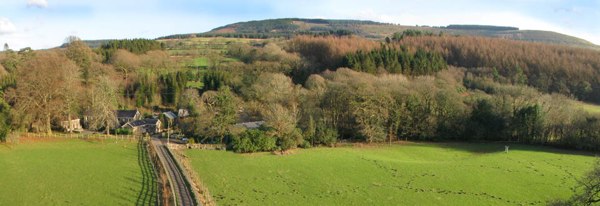
Plas Farm nestles in woodland at the foot of Mynydd Marchywel.
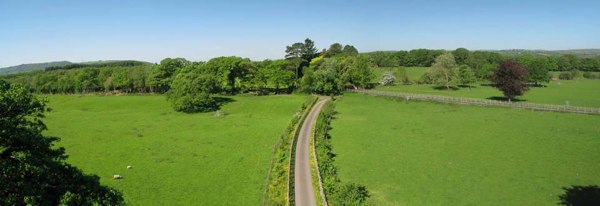
Beautiful grazed parkland that surrounds the tree lined drive that leads to the holiday cottages. Enjoy peace and tranquillity and yet still have modern amenities and world class attractions on the doorstep.
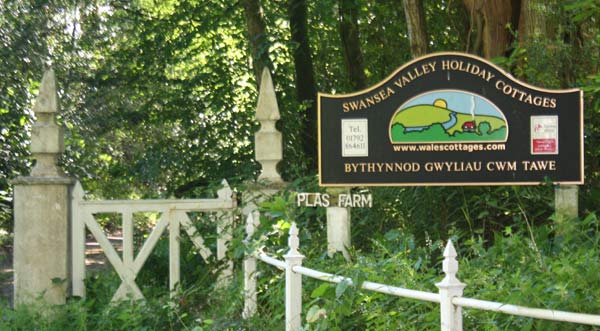
Plas Farm Entrance
The gateway to Plas Farm is marked by white pillars, through which a long tree lined driveway leads guests to their holiday cottages which are situated around a courtyard on the bank of the River Clydach. The backdrop of Mynydd Marchywel comes into view as one travels down the driveway.

Renewable Energy
Our eco-friendly holiday cottages get all their heat and hot water from one large biomass boiler that burns either FSC approved wood chips sourced from a local woodland or wood pellets which are made from the residue from saw mills. Biomass is an attractive fossil-fuel alternative because it is a renewable resource that is more evenly distributed over the Earth’s surface than finite fossil-fuel energy sources such as coal, oil and natural gas, and may be developed using more environmentally friendly technologies.
